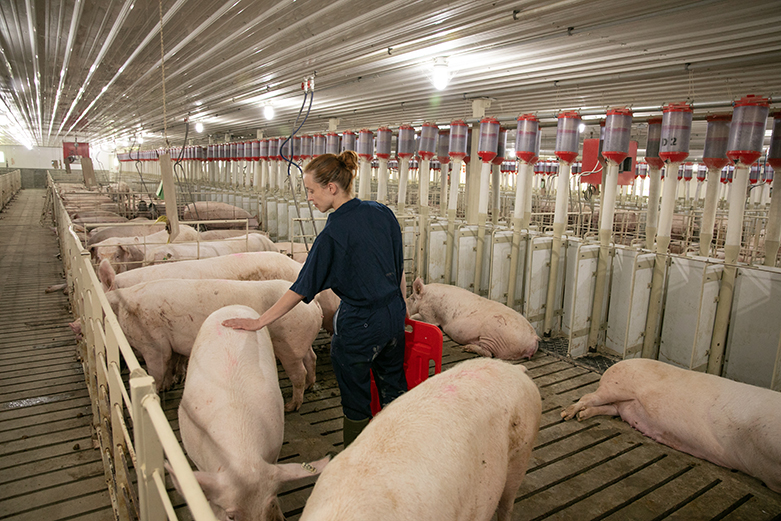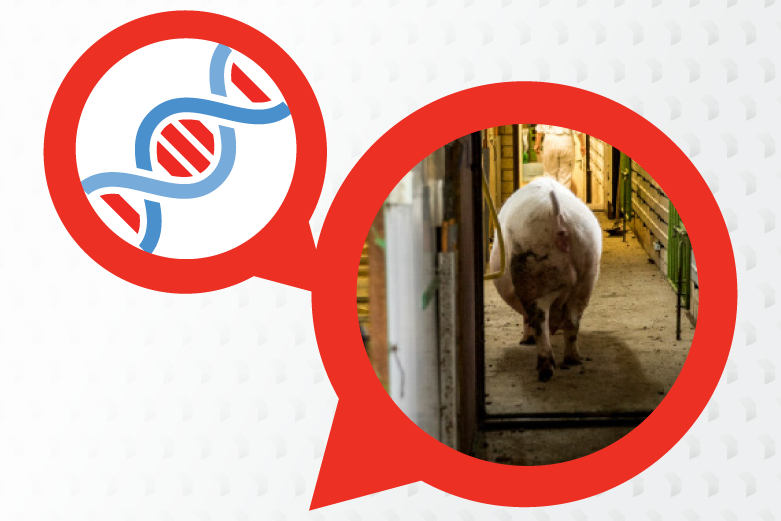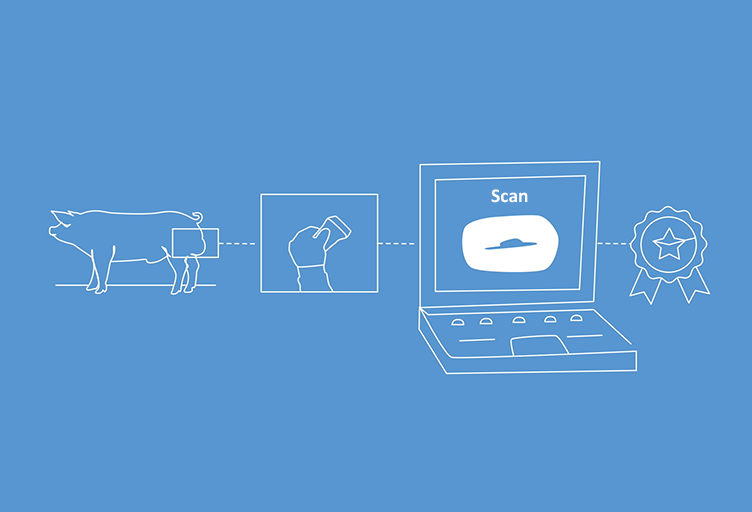Resilience, a term we have come across again and again recently. As resilience of a company, as resilience of people, e.g., in the context of the Corona pandemic, but also in relation to animal health.
 We asked Dr Pieter Knap, who is responsible for the genetic strategy at PIC, what resilience means for the geneticist, how the associated traits are inherited and whether we can breed for them.
We asked Dr Pieter Knap, who is responsible for the genetic strategy at PIC, what resilience means for the geneticist, how the associated traits are inherited and whether we can breed for them.
1 – What does a geneticist understand by resilience?
The production performance of a farm animal depends on its genetic potential, and even more so on the husbandry and feeding conditions on the farm. If these conditions deteriorate, an animal with higher resilience will be better able to express its genetic potential and thus maintain its performance. It is more robust. This is not an all-or-nothing trait, but a more-or-less trait, quasi from 0 to 100. And this resilience is also partly genetically determined.
2 – How can such a “deterioration of conditions” look like?
This includes everything that can affect performance: Inadequate nutrition, the climate (too cold, too hot, too poorly ventilated), social stress in group housing, and of course infectious diseases. For each of these stressors, there are animals (and humans…) that can cope better than others.
3 – How do farmers benefit from resilient animals?
Resilient or robust animals cope better with stressors. If the housing or feeding conditions on the farm deteriorate, then they maintain their production performance better. If conditions improve again – and we should always assume that they will – then they perform even better.
4 – What does resilience mean in direct relation to health? Resistance is often spoken of, but also resilience.
This is about resilience against infectious diseases. This has two components: Resistance and Tolerance.
My resistance to a disease depends on the quality of my immune system: For example, if my white blood cells function better, then my body is better able to kill pathogens before they can do any harm: Then I am more resistant – also a more-or-less trait.
If my immune system is activated by an infection, then creating the antibodies costs energy and protein. And I don’t feel well, often lose my appetite, have a fever, and that costs a lot of energy. If I were a fattening pig, my body’s first reaction would usually be to reduce my growth rate: The production performance goes down. This is my body’s reaction to the activation of the immune system. And if my resistance is not sufficient and the pathogen breaks through because of that, then the next question is how the body deals with the damage. These two reactions of the body (the immune reaction itself and the reaction to the damage caused by the pathogen) form the second component of disease resilience, namely disease tolerance. Biologically, a very different characteristic from resistance, and also a more-or-less characteristic.
5 – Are there cases where animals are not resistant but 100% tolerant?
Yes, a current example is African swine fever. The ASF virus has been an innocent commensal of the African warthog for centuries [commensal: Organism that feeds on the food of a (non-species) host organism without harming it]. They are not resistant to it, they carry the virus around inside them, it multiplies in their bodies, and they infect each other. But they are highly tolerant: They do not get sick; the virus does not harm them. In 1905, European domestic pigs were imported to Kenya, and were kept there very extensively, so they easily came into contact with warthogs. And that’s where today’s epidemic started, because domestic pigs are not tolerant to ASF at all: They die because of a hyper-reaction of their own immune system. It is not the virus that kills them, it is their own immune system that is activated by the virus and then sort of freaks out.
The same is true for Ebola in Africa, for example: A harmless bat virus that has found its way to antelopes, monkeys and humans, who die from it because of their non-tolerance.
6 – Can resistance and tolerance be measured individually?
Yes, but not simply because it has to be quantitative: All-or-nothing is not very helpful for selection in normal animal breeding – we need a number, like 23 or 84. To quantify resistance, you then have to somehow count the amount of pathogens in the body. For intestinal parasites in sheep, you count the eggs in a faecal sample under the microscope. For bacteria and viruses, there are laboratory tests, such as the Covid rapid tests that we are all familiar with by now. The crucial question for the Covid test is “infected or not”, but with a little extra effort it also works quantitatively: How much is someone infected? This is expensive: A PCR test for PRRS costs about 30 euros.
Measuring tolerance is even more elaborate, because it is about the body’s reaction to the infection pressure. This requires at least two data points: One at a low infection pressure and one at a higher one. This is difficult in the same animal, so it would be more practical for breeding to work with groups of relatives. Progeny groups of AI boars, for example.
Conclusion: It is possible, but complicated and expensive. Not suitable for pig practice as of today, we have to wait for better technologies. In the meantime, we do the next best thing: We select for production performance under non-optimal conditions, i.e. for resilience per se. The good thing, of course, is that we increase resilience from one generation to the next. The disadvantage is that we do not know to what extent the improvements are made via improved resistance or via higher tolerance. This would be particularly important in the case where resistance and tolerance are negatively correlated, because this could then easily lead to unexpected and undesirable changes in one of the two, usually the one with the lowest heritability.
7 – An animal is neither resistant nor tolerant and becomes infected. Which characteristics and circumstances are favourable and which are not?
An animal with resistance = 0 and tolerance = 0 can neither eliminate the pathogen (resistance) nor its damage (tolerance). It is then hopeless: It will die.
Animals (and humans) with low resistance and low tolerance should be vaccinated: This is always the best solution, and often the only one. Also for the more highly resistant and tolerant: Vaccination is always a good idea. But you need a vaccine for that, and for new diseases it usually takes a long time. I know scientists who have been working on an ASF vaccine for 20 years, it’s a very complicated virus with little relationship to other viruses, so they have to build everything from scratch.
8 – So, geneticists don’t want superspreaders?
Highly tolerant animals (and humans) do not need resistance: After all, they are tolerant, they do not get sick (or only a little). If they are infected, the pathogen can remain active in their bodies for a long time; and all the time they can transmit it to others. We know this from the early days of the Covid epidemic: Healthy young people who went on a skiing holiday in northern Italy, came back with the virus and then just felt a bit sick for a few days – they spread the virus for a few weeks without knowing it. So being very tolerant is beneficial for the individual but can be very dangerous for the group in which they live – unless the whole group is highly tolerant (as with the warthogs) or highly resistant (for example, because vaccinated).
9 – Can genetics predict which animal is prone to superspreading and which is not?
For that, you have to quantify tolerance. And as I said, that is difficult.
10 – Why is herd resilience so important?
Resistance is a characteristic of the individual: It influences individual resilience. The course of a disease outbreak in a group naturally depends on this: If many group members are sufficiently resistant, an epidemic has little chance. But there are two other components: Infectivity and curability. An infected animal is usually also infectious, it can spread the pathogen among its group mates. The extent to which this happens depends on the group dynamics: How intensively it comes into contact with them, the size of the group, etc. And this continues until the immune system of the infected animal has cleared its body of the pathogen, and this is where the balance between resistance and tolerance again plays an important role: Highly resistant animals get rid of the pathogen quickly, but highly tolerant animals can be infectious for a very long time. Herd resilience is therefore more than just the average of individual resilience values.
11 – PIC has been collecting practical data for years. What and how exactly do you measure or calculate resilience?
Yes, we have been doing this since 2003. Young nucleus boars are first used on crossbred sows in commercial farms before they are used for pure-bred matings. The cross-bred offspring (currently a good 100,000 annually) are fattened and slaughtered as conventional fattening pigs, and their performance data are fed into the breeding value estimation of their purebred half-siblings (the selection candidates in the nucleus). From the slaughterhouse we get back the usual data: Slaughter weight, lean and muscle pH. And from the farm: Abnormalities and mortality. These farms have average health status and commercial housing conditions, and so production performance is a useful indicator of resilience.
12 – Should the environment remain “unfriendly” on the test farms? What do you do when the farm has improved significantly, and the health status has approached that of a nucleus farm?
Then we have to find another test farm. Without problems there is no variation, and without variation no genetic improvement is possible. Such data can only come from problem farms.
13 – In addition to resilience in terms of animal health, there is also so-called social resilience. What does this mean? Heat can also become a stress factor. Are there animals that cope better with rising temperatures?
Yes, and cold too. Heat stress is a major stressor in dairy cows in the southern US and South America, and the resilience associated with it is heritable. We also see it in lactating sows. And social resilience is especially important in group housing; we humans are highly variable in our social behaviour and it’s the same in other mammals. The ability to deal with different group mates is also variable and hereditary in pigs.
14 – To what extent are resilience traits heritable?
This depends on the genetic structure of the resistance and tolerance mechanism for the disease in question. Coli F4 and F18 resistance in pigs is regulated by a single gene, that is very highly heritable. This is also true for scrapie resistance in sheep, and IPN resistance in salmon. Resistance mechanisms with a more conventional genetic background (many genes, each with a small effect) show heritabilities of up to 40%. Estimates for tolerance are lower, ranging from 10 to 20 %. I know of two studies on the genetic background of infectivity (in dairy cows and in turbot) where significant genetic variation was found, but the heritability could not be calculated because the statistical models were too complex; but heritability is quite clear.
15 – How long does it take to provide more resilient animals?
We have been doing this for years… see question 11. A completely different method to classical selection is genome editing, which we are currently using to achieve 100% resistance to PRRS. This virus uses a very clever way to reproduce in the pig’s body: It hijacks a certain protein in the white blood cells. This protein looks like a little chain of nine beads, and the virus binds to bead number 5. We then remove the piece that regulates this bead from the gene, the pig then no longer replicates/produces bead number 5, and thus the virus cannot replicate. In other words, the pig is completely resistant. The method itself was developed around 2013, and we hope to get approval to sell these animals around 2025, primarily in North America and Asia. In Europe, it will take much longer. So, to answer the question, this kind of thing easily takes twelve years.
16 – Are there other approaches to improving resilience besides breeding?
Let’s hope so… with 10 to 40% heritability, 60 to 90% of the variation is environmental. But I am a geneticist; you will have to ask others what happens in the non-genetic fields.
Resilience – a very complex topic and wide field that can only be dealt with in an interdisciplinary way. Especially regarding herd resilience, epidemiology and diagnostics are intertwined. New computational models, further epidemiological studies, new technologies etc. will help to further improve the resilience of our animals and contribute to sustainability in animal production.
It remains exciting … Never Stop Improving.




